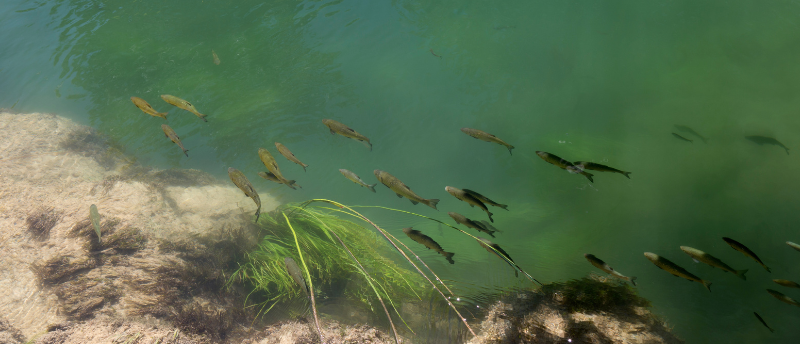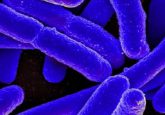For fish dealing with oxygen-deficient environments, size does matter

Body mass and cell size are major factors in a fish’s ability to withstand temperature-dependent, low-oxygen environments.
Fish worldwide are being plagued by larger and more frequent episodes of hypoxic environments. Hypoxia occurs when the concentration of dissolved oxygen in an aquatic ecosystem is low enough to limit the rate of uptake of oxygen by water-breathing animals. This leaves aquatic animals with insufficient oxygen to meet their metabolic demands and is hence an existential threat to aquatic life.
Whilst there are myriad factors that can deplete oxygen levels in aquatic habitats, the scientific consensus is that anthropogenic climate change is the root cause of these longer and more severe cases of hypoxic environments. A fundamental property of water is that with increasing temperature its ability to retain dissolved oxygen decreases.
Some fish species are intrinsically better at coping with lower oxygen levels than other species. An international collaboration of marine biologists, led by the Radboud Institute for Biological and Environmental Sciences (Radboud University; Nijmegen, Netherlands), has released a paper analyzing the characteristics of certain fish species on an anatomical, physiological, and genetic level that renders certain them better equipped to cope with warming waters and lowering oxygen concentrations.
The aim of the research was to use an expanded existing database to construct a more holistic approach to probing the issue. The first author of the study, Wilco Verberk (Radboud University, Nijmegen, Netherlands), explained: “Many oxygen hypotheses are being fiercely debated. The problem is that the various effects are lumped together. For example, some studies look at how fish respond to oxygen levels in the water but do not account for the temperature of the water or the size of the fish. As a result, the reported patterns are variable”.
Verberk and colleagues focused on one key value, known as Pcrit, to indicate the extent an individual fish species was able to tolerate low levels of dissolved oxygen. Pcrit is the critical oxygen tension and is the lowest concentration of oxygen at which a fish can fuel its basal metabolic rate. At this point, the gills of a fish are pushed to their absolute maximum to provide the minimum required amount of oxygen.
 The ultimate antibacterial sponge
The ultimate antibacterial sponge
Researchers find that Agelas dispar, a type of sea sponge, contains compounds capable of killing common drug-resistant bacteria and could lead to new antibiotics.
A database comprised of 195 unique fish species was used in the study. Phylogenetic data for each species, the degree of shared genetic history between fish species, was also used as a factor in the statistical analysis of the database. The team’s multilevel modeling framework was used to describe Pcrit as a function of body mass, genome size, measurement temperature, acclimation temperature, salinity and the method of respiration for each species.
When it comes to withstanding low oxygen levels in warmer waters, size definitely matters in fish. Data analysis displayed that in warmer waters, fish with a larger body mass are more susceptible to a scarcity of oxygen than smaller fish. Interestingly, this phenomenon is entirely reversed in colder waters.
Fish with larger cells were found to be more susceptible to oxygen levels in warmer waters and overall, cell size and body mass yielded similar results as body mass in terms of hypoxia tolerance. Genomic size is a strong indicator of cell size in fish and the larger a cell gets, the lower its membrane surface area-to-cell volume ratio becomes. Consequently, a relative decrease in surface area increases diffusion time and limits the rate at which oxygen can enter cells.
 Grow in the dark: photosynthesis that doesn’t require sunlight
Grow in the dark: photosynthesis that doesn’t require sunlight
An electrocatalytic process that creates acetate and allows plants to undergo photosynthesis without sunlight has been developed, which could improve global food security.
The team’s analysis also noted that freshwater fish are better equipped to cope in low oxygen environments than saltwater fish, analysis which they felt set their research apart from others. “Far too often, scientific studies only compare marine and terrestrial life,” said Verberk. “Indeed, freshwater species are sometimes lumped with terrestrial species. It is a missed opportunity because taking these differences into account can greatly increase our understanding of the environmental impacts of climate change.” Verberk and colleagues discovered that through the evolutionary history of freshwater fish, they have developed to adapt to certain environmental pressures that naturally deplete oxygen levels in freshwater ecosystems, for example, eutrophication or algal blooms. Additionally, variations in temperature are more pronounced in lakes and rivers than they are in seas or oceans.
The conclusions that the team has drawn from this study give us an indication of how marine life may adapt to the further warming of the world’s waterways. Fish of different body masses and cell sizes may have to shift geographic distribution and migratory habits, with smaller species preferring warmer waters and larger species retiring to cooler waters. Whole ecosystems may be affected as body mass has a disproportionate effect on fish fertility and their ability to reproduce in large numbers.
Nature is fragile and if one population explodes or collapses, it can mean extinction for several others. Human behavior, like fishing, may also be affected by hypoxic environments. Whilst no absolute predictions can be made from this paper, the authors are confident that the work detailed in this article will allow for more refined and sophisticated models of tracking the global fish population in the years to come.





